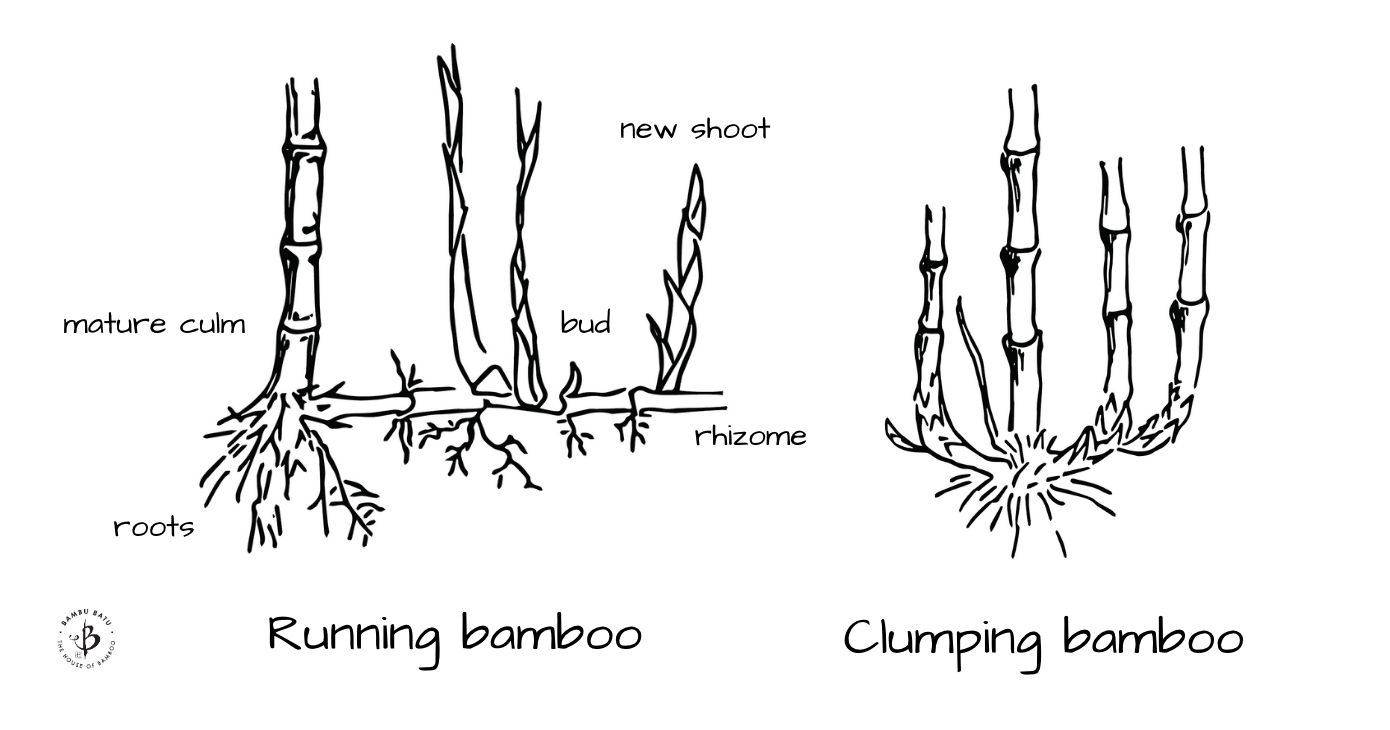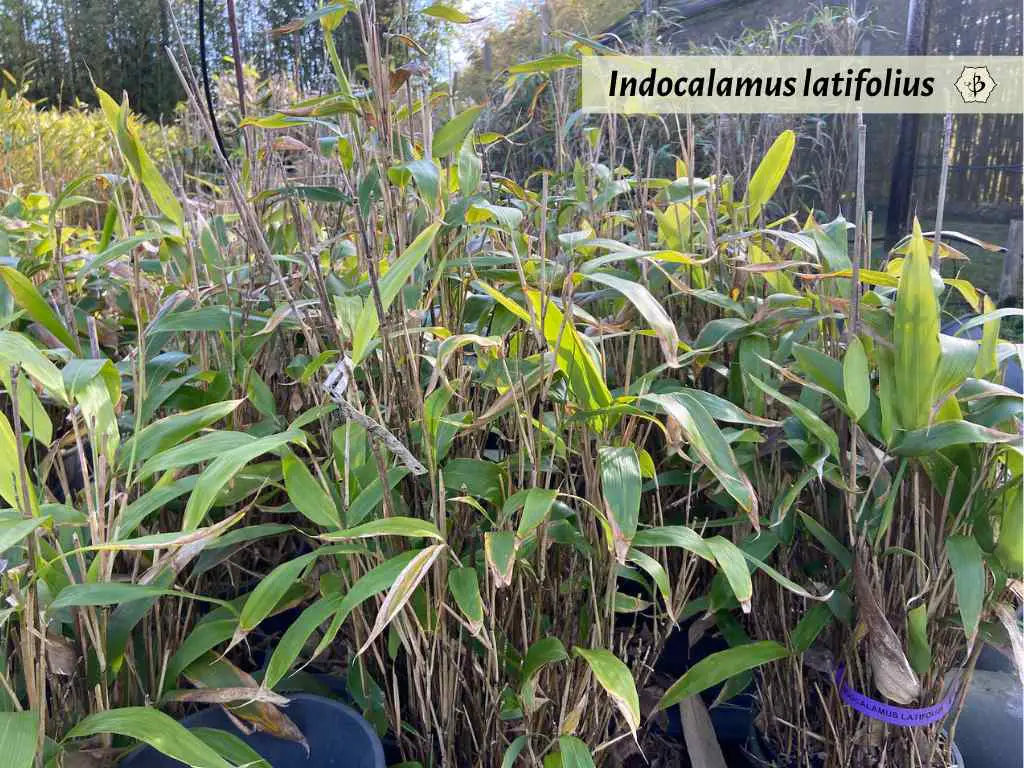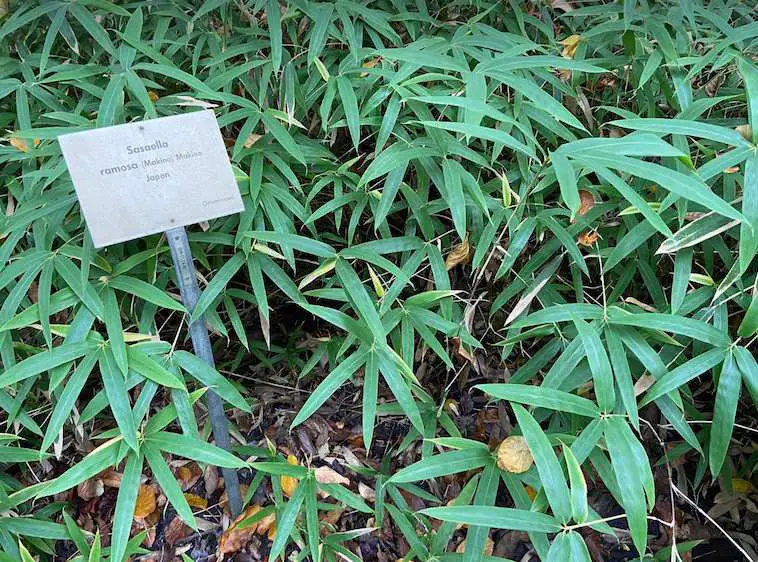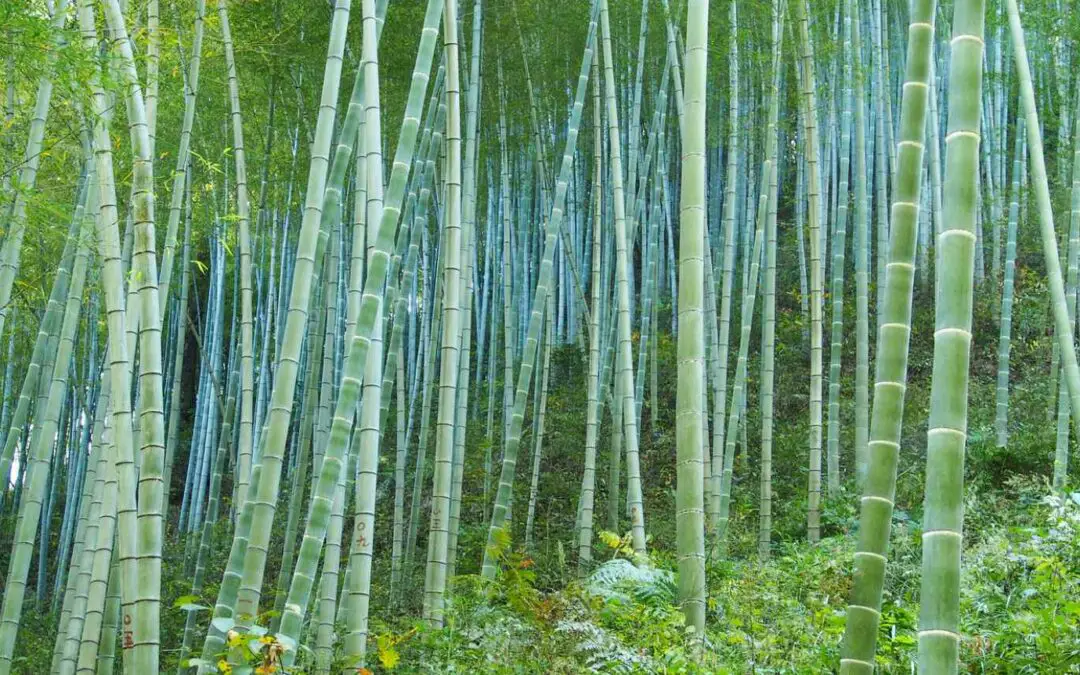Bamboo has so many practical uses, it’s like nothing else in the plant kingdom. Beginning thousands of years ago, people were using bamboo to make paper, spears, and primitive housing structures. More recently we have discovered how to make beautiful flooring and exquisite fabrics from bamboo. As a plant, bamboo is also extremely useful for privacy hedges and erosion control.
As an alternative to retaining walls and other man-made structures, bamboo can serve as an excellent means of erosion control. Whether you’re dealing with grades and terraces on a sloped property, or the loss of topsoil to river beds and irrigation run-off, the mighty roots of a well-established bamboo plant will provide a remarkable solution to erosion and other related problems. While some people are apprehensive about growing bamboo on their property, for fear of the damage it can do, bamboo can also be effective in holding your property together. Given the great diversity of species, certain varieties of bamboo are naturally more beneficial than others in terms of erosion control.
In the following article — first published in September 2020 and most recently updated in March 2024 — we’ll look at what makes bamboo, especially its roots, so valuable and effective for controlling erosion in a variety of settings. We’ll also consider the dangerous side effects that an aggressive bamboo plant could present. Then we’ll look at some of the best types of bamboo to plant for the purpose of preserving your hillsides and mitigating erosion.

When to use bamboo for erosion control
Bamboo provides a natural, inexpensive and effective solution to control erosion and preserve terrain in a wide variety of situations. It has proven effective around the world, in Asia, Africa, Europe and the Americas. Live bamboo, especially its vigorous root network, works in different ways to:
- consolidate topsoil
- stabilize slopes
- preserve river beds
- prevent runoff
- discourage trampling
- reduce evaporation
From small-scale residential settings, to large-scale habitat preservation projects, bamboo has what it takes to hold the terrain in place. Bamboo grows easily in many climates and soil types, on flat terrain or on slopes. From warm tropics to the hillsides of the Himalayas, there are species that will thrive in nearly any environment.
Residential gardeners will find bamboo one of the most effective plants for keeping their slopes where they belong. The roots of bamboo, nearly as strong as steel, spread out and hold the soil together, preventing it from giving way to the effects of wind and rain. The bamboo also generates a natural layer of mulch, an added layer of protection, as the leaves fall and gather around the base of the culms.
The presence of a dense, woody grass has an additional benefit, keeping out larger intruders. The activities and footfalls of humans and large mammals would otherwise degrade the slopes and lead to additional erosion.
As the unpredictable effects of climate change continue to present new environmental challenges, including droughts and floods, resilient methods of erosion control are becoming ever more useful and necessary. Planting bamboo along waterways is a particularly effective way to limit the loss of land into riverbeds as the weather patterns change, bringing more erratic typhoons and hurricanes.
Harvested bamboo is also useful as a way of preventing erosion. Those long, sturdy, lightweight poles provide an ideal material for building cost-effective retaining walls in rural areas. These areas in Africa and southern Asia are often hardest hit by climate change disasters, as described below. Furthermore, they also have the least access to modern, industrial solutions. But they do have a reliable supply of bamboo.
Bamboo growth in Africa
Bamboo farming is booming in Africa, and erosion control is one of the top incentives for planting. Kenya experienced some massive flooding and landslides back in 2018, displacing more than 300,000 people. Now Kenyans and others are turning to bamboo as a viable solution to reduce the impact of future disasters.
Changing climate and new patterns of precipitation are transforming waterways and reshaping the landscapes. A resilient plant that can tolerate storms, droughts and some degree of flooding, bamboo has the strength to survive and to hold a fragile landscape in place.
See our in-depth article on Bamboo in Kenya.
Erosion remedies in India
India has also felt its share of climate disruption, with unprecedented storms and floods, and they too are looking at bamboo for stability. The Kasaragod district has proposed the Bamboo Capital project to encourage more widespread cultivation of bamboo as a way of preventing or minimizing more landslides in the future.
Given bamboo’s great potential as a cash crop, policymakers recognize that using bamboo for erosion control will also confer other economic benefits to the region. Local farmers can begin harvesting bamboo within five or six years, to sell as a commodity or to use for all manner of light construction.

Bamboo roots: A force of nature
Some gardeners struggle with bamboo, as the plant can grow so vigorously, sometimes becoming invasive. Indeed, if you plant a running bamboo when you should have chosen a clumping bamboo, you may end up battling a force of nature. At the same, you can also harness the power and tenacity of these bamboo roots and put them to good use. One of the best uses, as we have seen, is for controlling erosion and restricting landslides. Agronomists have recognized these beneficial properties for a long time.
With a little planning and forethought, the most intimidating features of bamboo can make the plant an ally rather than an adversary. The aggressive rhizome roots of bamboo plants are famous for how quickly they can spread, and for how difficult they can be to remove. Once the plant is established, the running rhizome roots can quickly infiltrate your entire garden, becoming nearly impossible to eradicate.
If you’re trying to maintain a pristine flower bed or an undisturbed lawn, free of weeds and dandelions, an aggressive bamboo plant could become your worst enemy. In this case, you’ll be far better off keeping your bamboo in a large container or planting a clumping variety. A flourishing clumper can make a great addition to any garden, either as an accent or a centerpiece.
Know your bamboo: Runners vs. Clumpers
Before you rush into planting bamboo in your garden, and before letting your next-door neighbor talk you out of it, you need to understand the difference between running and clumping bamboo. We can pretty well divide the 1,200+ species of bamboo into these two categories.
Clumping bamboo, as the name indicates, tends to grow in a tight, dense pack. That’s because the rhizome roots are mostly u-shaped, naturally inclined to grow upwards. Most clumping bamboo species will gradually spread to a certain size, and then max out. But there are also “open clumpers”, whose footprints will continue to spread, but slowly. And there are other clumpers with unusually deep roots, which can also provide excellent erosion control.

Running bamboos, on the other hand, have rhizome roots that grow horizontally and outward. Once established, usually within two or three years, the roots start reaching out across the soil, but silently and invisibly, underground. These are the kinds of bamboos your suburban neighbors are warning you against.
But if you have a larger property, especially one with uneven terrain and varying topography, these are the kinds of bamboo that can hold your terrain together most effectively. The smaller your garden, the less likely you are to be planting a running bamboo. But if you’re interested in erosion control, then you probably have a good piece of land, more than just a suburban parcel.
Bast bamboo varieties for erosion control
The best kinds of bamboo for erosion control are generally those with the most vigorous rhizome systems. Usually this means runners, whose roots will spread far and wide to form a web-like network that can hold the land in place. If you’ve ever tried to eradicate an established grove of bamboo, then you probably already know how hard it is to break up such a network.
But even more important, for reducing erosion, is the depth of the roots. And some clumping bamboos, while less inclined to spread outward, actually have roots that go deeper downward.
Some of the best bamboo species for residential erosion control are dwarf varieties, which behave more like a ground cover. There are a number of them which can spread quickly and put down deep roots, without overshadowing your garden with towering culms.
Arundinaria gigantia: Giant cane bamboo or river can bamboo is one of the only species native to North America. This running variety once covered great swaths of the Deep South, but now only grows in more limited areas. It’s a relatively cold-hardy species with deep roots, and slender canes that grow 15-20 tall.
Arundinaria tecta: Another species native to North America, this is the shorter version, which only grows about 6-8 feet tall.
Bashania fargesia: Also known as “windbreak bamboo”, because of its long, sturdy culms. Leaves are long and thick, and the culm internodes are unusually long. This cold-hardy variety is good in zones 7-10, and gets about 20-25 feet tall, with culms up to 2″ thick. Beware, this species is an especially fast-spreading runner, with long rhizomes, quite capable of becoming invasive.

Indocalamus tessellatus: This unusual, cold-hardy bamboo species makes a fabulous addition to any enthusiast’s collection. Often referred to as Giant Leaf Bamboo, it has the largest leaves of any bamboo variety. While the plant itself only gets about 6-8 feet tall, the leaves have been known to grow as much as 2 feet long and 4 inches wide. Tenacious roots are very effective against erosion.
Melocanna baccifera: Native to northeast India and Southeast Asia, this clumping bamboo is more famous for its gregarious flowering event. But it also has deeper and stronger roots than many other bamboo varieties. For this reason, they commonly use this bamboo species to prevent erosion along river beds and waterways in India.
Phyllostachys humilis: One of the most prolific genera of bamboo, Phyllostachys are all runners with notoriously vigorous rhizomes. P. humilis is one of the shorter members of the genus, growing about 10-20 feet tall. Internodes are short, and the foliage is bushy, with small and delicate leaves. Spreads quickly for a privacy hedge and also works well for erosion control.
Pleioblastus pygmaeus: A popular species for ground covers and in containers, but don’t be fooled by its short stature. Though it only grows a couple feet tall, the running roots are bold and swift. They can take over a garden within a couple of years. The robust roots and low profile make this an ideal variety to control erosion on slopes and hillsides, holding the soil together without overshadowing the whole landscape.

Sasaella ramosa: Another genus of fast-spreading dwarves, Sasaellas are compact runners that can really beautify a garden without towering over it. S. ramosa gets about 3 feet tall and is cold hardy down to around 0º F. Thick dense foliage makes for an attractive ground cover capable of holding an undulating landscape in place.
Semiarundinaria okuboi: This running bamboo provides a low, dense hedge. It typically grows 10 to 15 feet tall, with slender culms and wide leaves. This variety spreads aggressively and is excellent for erosion control. It’s also an attractive ornamental.
Yushania brevipaniculata: Also classified in the genus Borinda, depending on your taxonomical system, all species of Yushania are clumpers. But these are a fast-spreading variety, usually referred to as an “open clumper”. The unusually deep roots make this a superior choice for erosion control. A relatively short bamboo, this semi-compact variety only gets about 6-8 feet tall. The species does especially well in cold and shady settings, and won’t be happy in very hot climates.
Further reading
If you enjoyed this article about growing bamboo for erosion control, and found it useful, please consider sharing the post and subscribing to our blog. To learn more about the incredible properties of bamboo, check out some of these other interesting articles.
- The benefits of bamboo
- Bamboo for soil enrichment and restoration
- Bamboo and carbon sequestration
- Timber bamboo: The greatest of grasses
- Drought tolerant bamboo
- Best bamboo species for building and construction
- The most invasive varieties of bamboo
- Growing Bamboo: A complete how-to guide
PHOTO CREDIT: Bamboo covers a mountainside in Hang Zhou, China (Unsplash)


























I need guidance on the best variety of bamboo to stabilise a river bank in Uganda East Africa
Hi Lydia, Take a look at this article about Bamboo in Kenya. Many farmers are using bamboo for erosion control in Kenya, and this article discusses a number of species. Good luck!
I need Guidance on the best variety of bamboo to help stabilise the bank in my garden please.
You can use my calendly link down below to schedule a call.
I am very interested. I plan to allocate 5 hectares of hilly land with a river to plant bamboo for commercial/bldg purposes. Preferably our own Philippine varieties.
Some of the Philippine varieties are excellent for building materials